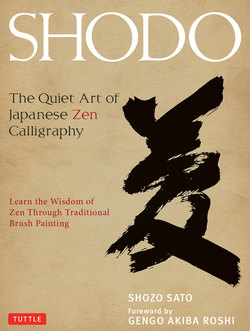Читать книгу Shodo - Shozo Sato - Страница 6
На сайте Литреса книга снята с продажи.
ОглавлениеForeword
Bokuseki are writings by Zen priests which also serve as an introduction to Zen philosophy. In my opinion, Professor Sato’s concept to use these “statements” as a guide for shodo makes this one of the finest introductions to the art. Considering the sho (writing) of bokuseki brings to light the spiritual side of sho along with the source from which such writings come.
Each of the zengo, or statements from Zen philosophy, are written here in three calligraphic styles—kaisho (formal), gyosho (semi-formal) and sosho (informal)—and provides you with an opportunity to study and compare the works of Zen priests, professional sho artists, and other people whose interest led them to study the art of sho. The wide range of examples shows how individual personality is revealed through the practitioners’ writing, and this makes this book an exemplary teaching tool.
There is great freedom and spirituality in the brushwork of the bokuseki written by the many well-known Zen priests in these pages. When written with a brush and sumi ink, ideograms impart vast depth in artistry. This is the beauty and charm that is being introduced through this book. Most importantly, while one is practicing the copying of ideograms, there is also the opportunity to ponder over the meaning of the Zen statement.
While there are many “how to” manuals on the shelves of bookstores that are designed to teach Chinese ideograms, commonly referred to as characters, the type of guidance offered in those books is aimed at mastering the most common ideograms in written Chinese, not at developing artistic style. Traditionally Chinese poetry has been used as a “copy book” source by shodo practitioners, serving as a model to follow for improving one’s style. The person who instead uses Shodo as their guide or “copy book” will benefit by eventually developing a great understanding of the depth in philosophical understanding and the range in beauty and artistry of ichigyo mono.
Professor Shozo Sato has spent the greater part of his adult life in the United States, where he has dedicated his time to teaching and disseminating, both here and abroad, the traditional cultural arts of Japan. His unwavering resolve has helped the students in his classes and the public at large to develop an understanding of Japanese arts and culture. At every opportunity, he has lectured at and conducted workshops for civic and educational organizations and institutions. Depending on the interests and age levels of his audience, his chosen topics range from the theatrical arts and ikebana (the art of arranging flowers) to chado (the tea ceremony) and sumi-e (Japanese ink painting). His work invariably helps people see how these arts explain the foundations of Japanese culture: how the Japanese think, how they develop concepts and ideas, and how they create and express themselves.
Among Professor Sato’s numerous publications, two recent books, Ikebana: The Art of Arranging Flowers and Sumi-e: The Art of Japanese Ink Painting, have been especially well received by teachers and learners. Over the years as he lectured and taught his courses on these arts and others, he became more deeply aware of how profoundly the traditional arts were rooted in Zen Buddhist philosophy, and that it was through Zen philosophy that the Japanese arts flourished and matured.
Zen philosophy and Zen aesthetics hold a unique position in the history of world culture. Today, across the United States, Zen Buddhism has been widely adopted. Thus this book comes at an opportune time. The person who begins the study of shodo through this book may well discover a freedom or release from certain attachments, especially to material things, and perhaps develop an interest in the dynamic processes of the mind as found in Zen Buddhism. Our world is filled with a material culture and many of our so-called “pressing needs” in daily life are based on that need. It is my sincere wish that readers will find the passage of release from materialistic social boundaries. Finally, I hope that this unique book will serve as a guide in many ways.
Gengo Akiba Roshi
Former Superintendent General, Soto Sect of Zen
North America International Missionary
